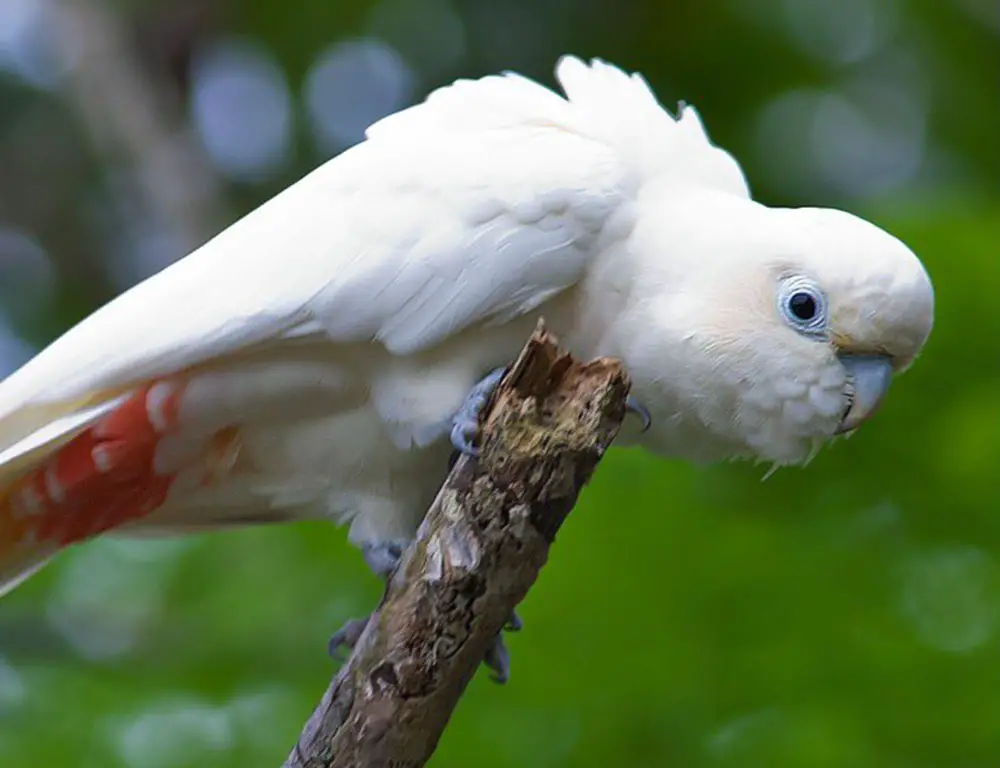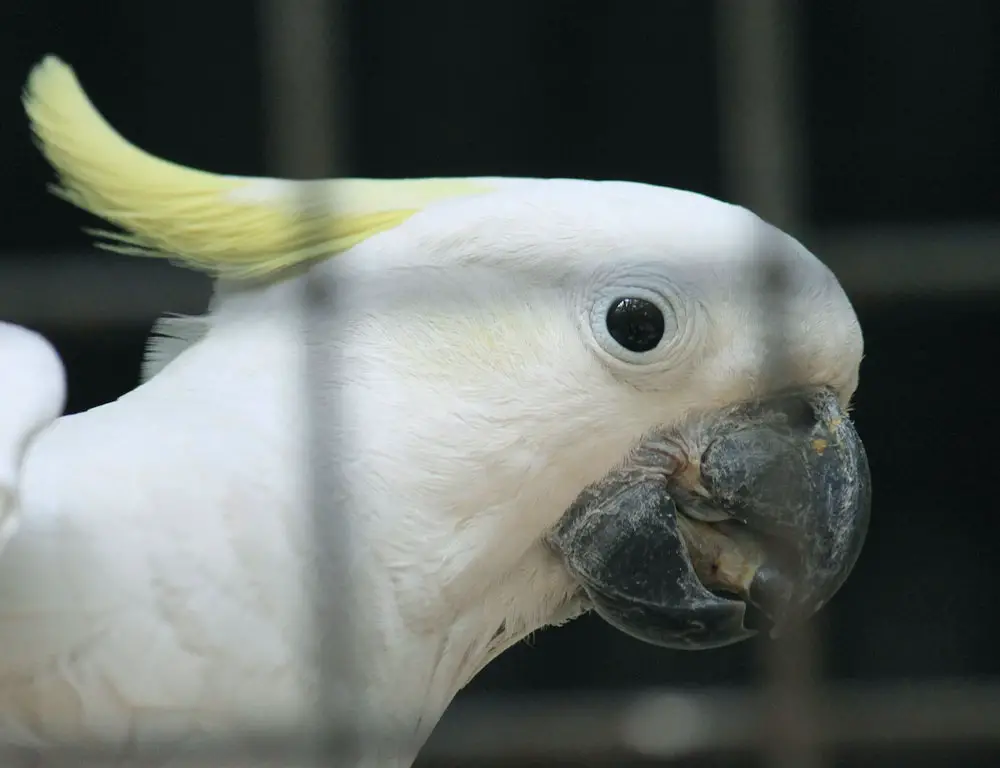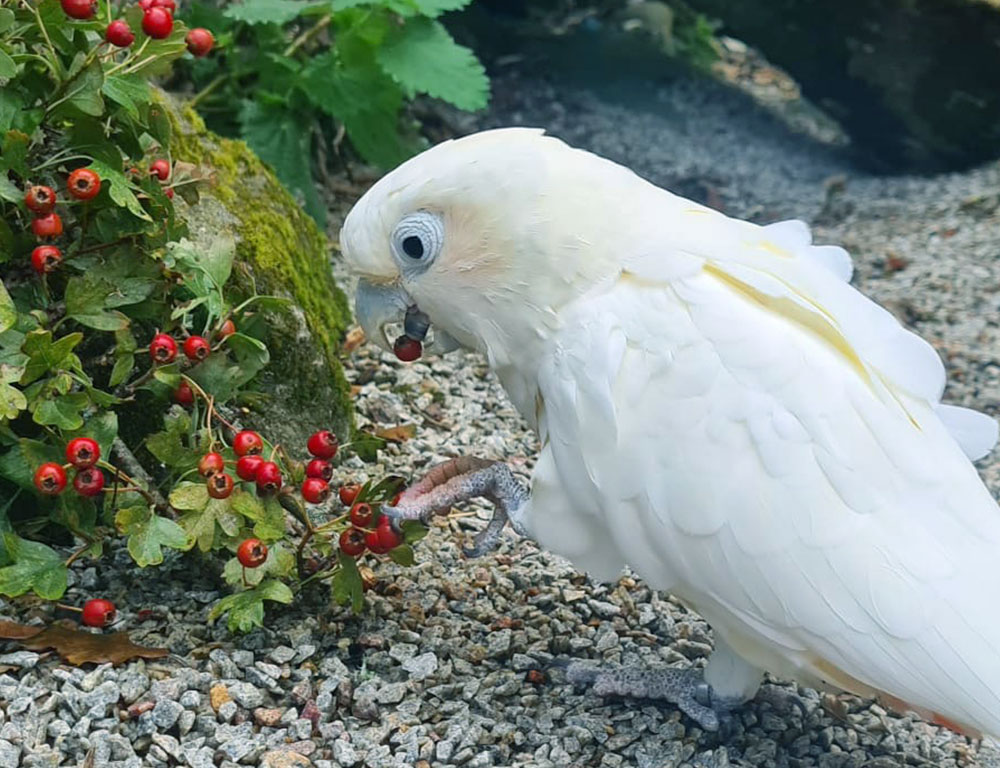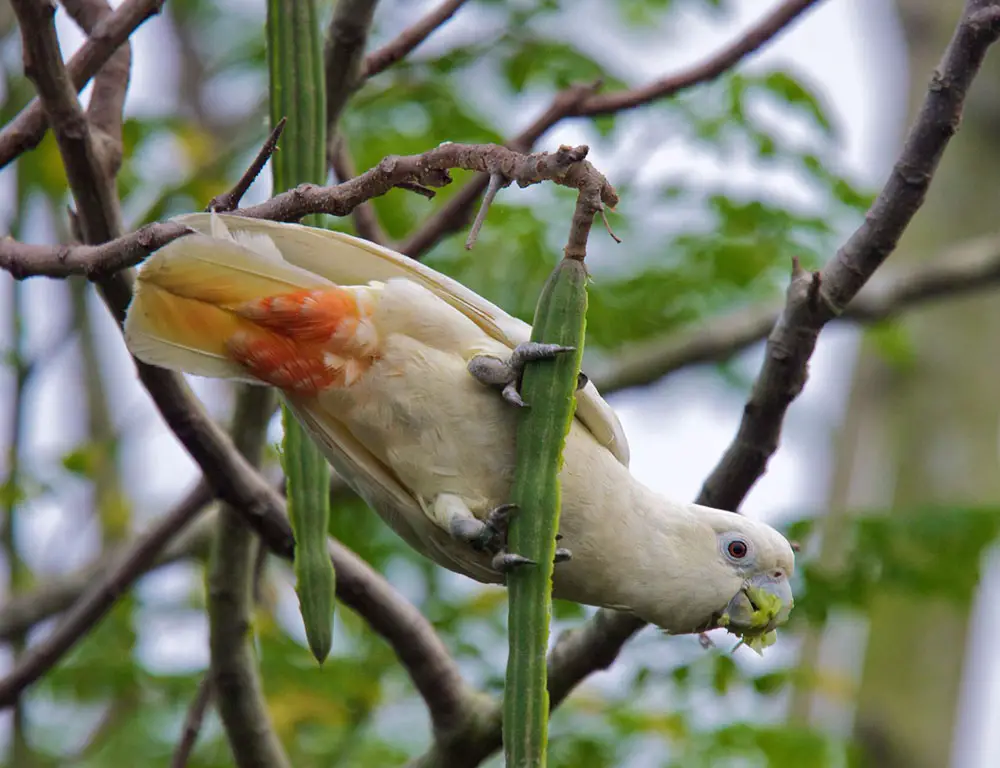As a dedicated bird enthusiast, my fascination with avian species has led me to the captivating realm of the Red-Vented Cockatoo, also known locally as the Philippine Cockatoo or Kalangay.
Endemic to the Philippines, this charming bird boasts an enchanting all-white plumage contrasted by its vivid red undertail coverts, earning it its distinctive name.
Despite its allure, the Red-Vented Cockatoo faces imminent peril, with its population rapidly dwindling due to threats like illegal pet trade and habitat destruction, landing it on the brink of extinction as classified by the International Union for Conservation of Nature (IUCN).
In this exploration, we’ll delve into the intricacies of this resilient bird’s behaviors, habitats, and its crucial role in our ecosystem.

Physical Characteristics of Red-Vented Cockatoo
The Red-Vented Cockatoo, scientifically known as Cacatua haematuropygia, has several distinct physical characteristics that contribute to its charm and allure.
Let’s delve into these features:
Size
Red-Vented Cockatoos are medium-sized birds, with adults typically measuring around 30-35 centimeters (12-14 inches) in length from the tip of the beak to the end of the tail.
Wingspan
The Red-Vented Cockatoo has a wingspan ranging from 46-56 centimeters (18-22 inches). This wingspan allows for agile flight and maneuverability, especially in its natural forest habitat.
Plumage
The Red-Vented Cockatoo displays predominantly white plumage covering its body, head, and crest. This white coloring serves as a canvas for its other distinctive features.
Red Undertail Coverts
One of its most striking features is the vibrant red feathers underneath its tail, known as undertail coverts. These feathers contrast sharply with the bird’s white plumage and are a key identifier.
Crest
Like many cockatoo species, it has a prominent crest on its head. The crest consists of long, graceful feathers that can be raised or lowered to express emotions or communicate with other birds.
Beak
The Red-Vented Cockatoo possesses a powerful beak adapted for cracking open seeds, nuts, and other food items. The beak is strong and hooked, allowing the bird to manipulate objects precisely.
Eye Patches

Around its eyes, the bird often displays circular patches of bare skin, usually blue or black. These eye patches add to its distinctive appearance and are a visual accent against its white plumage.
Habitat and Distribution of Red-Vented Cockatoo
The habitat and distribution of the Red-Vented Cockatoo, also known as the Philippine Cockatoo or Kalangay, are closely tied to its endemic range in the Philippines.
Here’s a closer look at where these birds are typically found:
Native Range
The Red-Vented Cockatoo is predominantly found in the Philippines, making it an endemic species.
Within the Philippines, they are most commonly sighted in certain regions, with Palawan and its surrounding smaller islands being primary habitats for these birds.
Preferred Habitats
Red-Vented Cockatoos exhibit a preference for specific types of habitats within their range. They are often found in mangrove forests and areas with coconut trees, where they can nest in tree cavities located high off the ground.
These habitats provide them with food sources, suitable nesting sites, and protection from predators.
Distribution
While historically, these cockatoos were also observed in Tawi-Tawi, sightings in that region have become rare. However, they remain in select locations across the Philippines, particularly in areas with suitable habitat conditions.
Coastal Areas
Red-Vented Cockatoos tend to favor coastal areas over inland regions, likely due to the availability of resources and nesting sites in mangrove forests and coastal habitats. These areas provide diverse food sources and offer protection from disturbances.
Conservation Concerns
Despite their preference for specific habitats, the Red-Vented Cockatoo faces significant threats to its survival, primarily habitat loss and illegal pet trade.
Destruction of mangrove forests and coastal habitats, in particular, poses a severe risk to these birds, leading to their classification as critically endangered by the International Union for Conservation of Nature (IUCN).
Behavior and Diet of Red-Vented Cockatoo

Let’s explore the behavior and diet of the Red-Vented Cockatoo:
Behavior
The behavior of the Red-Vented Cockatoo is fascinating and reflects its social, intelligent, and adaptive nature. Here are some key aspects of their behavior:
Social Behavior
Red-vented cockatoos are highly sociable birds, often seen in pairs or small family groups. They engage in various activities throughout the day, such as foraging, grooming, and socializing.
Their strong social bonds contribute to their overall well-being and survival in the wild.
Monogamous Mating System
These cockatoos exhibit a monogamous mating system, forming lifelong bonds with a single mate. During the breeding season, they display affectionate behaviors towards their partners, including mutual preening and sharing food.
This bond remains strong even outside of the breeding season.
Feeding Habits
The diet of red-vented cockatoos primarily consists of seeds from various plant species, with eucalyptus, acacia, and casuarina seeds being their primary food sources. They also supplement their diet with fruits and berries when available.
Their feeding pattern includes feeding early in the morning and late afternoon, with a rest period during midday to avoid the hottest part of the day.
Diet
Let’s delve into the diet of the Red-Vented Cockatoo:
Seed Predation
Red-vented cockatoos feed on seeds from various plant species, including eucalyptus, acacia, and casuarina. These seeds provide them with essential nutrients such as protein and fat, supporting their energy needs for daily activities.
Fruit Consumption
In addition to seeds, red-vented cockatoos also consume fruits and berries when available. These fruits are a source of vitamins, minerals, and antioxidants, contributing to their overall health and well-being.
Feeding Behavior
Red-vented cockatoos exhibit a unique feeding behavior with distinct daily feeding patterns. They are active feeders, often foraging for food in trees, on the ground, or in agricultural areas.
Their feeding behavior is influenced by food availability and environmental conditions.
Vocalizations
Vocalizations are an essential aspect of the behavior of the Red-Vented Cockatoo. Let’s explore:
Communication
Red-vented cockatoos communicate through vocalizations, including whistles, squawks, and calls.
These vocalizations serve various purposes, such as alerting others to danger, communicating with mates or offspring, and maintaining social cohesion within the flock.
Distinctive Calls
Their calls are loud and melodic, with whistles combined with squawks. These distinctive vocalizations help red-vented cockatoos communicate over long distances and play a crucial role in their social interactions and reproductive behaviors.
The Vital Role of Conservation Efforts in Safeguarding the Red-Vented Cockatoo

The importance of conservation efforts for the Red-Vented Cockatoo cannot be overstated, as this species faces imminent extinction due to various threats.
Here’s why conservation actions are crucial:
Preserving Biodiversity
Red-Vented Cockatoos are an integral part of their ecosystems. By protecting them, we maintain biodiversity within these ecosystems, ensuring the balance and resilience of natural communities.
Genetic Diversity
Conservation efforts help maintain genetic diversity within the Red-Vented Cockatoo population. Preserving different populations of these birds ensures that the species has the genetic variability necessary to adapt to changing environmental conditions and threats.
Ecosystem Services
Red-Vented Cockatoos play a vital role in ecosystem functions, particularly seed dispersal. These birds contribute to forest regeneration and maintaining healthy ecosystems by consuming seeds and dispersing them across their habitats.
Economic Value
Conservation efforts aimed at protecting Red-Vented Cockatoos can have positive economic impacts. Ecotourism centered around birdwatching attracts tourists, creating opportunities for local economies to thrive through bird-related tourism activities.
Preventing Extinction
The Red-Vented Cockatoo is critically endangered, with its population declining rapidly. Conservation actions, such as enforcing wildlife laws and combating illegal trade, are essential in preventing the extinction of this species and preserving it for future generations.
Conclusion
Our exploration of the Red-Vented Cockatoo uncovered its unique characteristics: the striking red vent, social nature, and diverse diet. However, the sad reality is its critical endangerment, primarily due to habitat loss and illegal pet trade.
It’s incumbent upon us to take collective action, advocating for conservation efforts and sustainable practices.
Raising awareness and supporting initiatives can safeguard these remarkable birds and their biodiversity.
Let’s embrace our responsibility to protect the Red-Vented Cockatoo, ensuring future generations have the privilege of experiencing their beauty and vitality.
This journey into their world reminds us of the power of knowledge in shaping our actions to preserve our natural heritage.